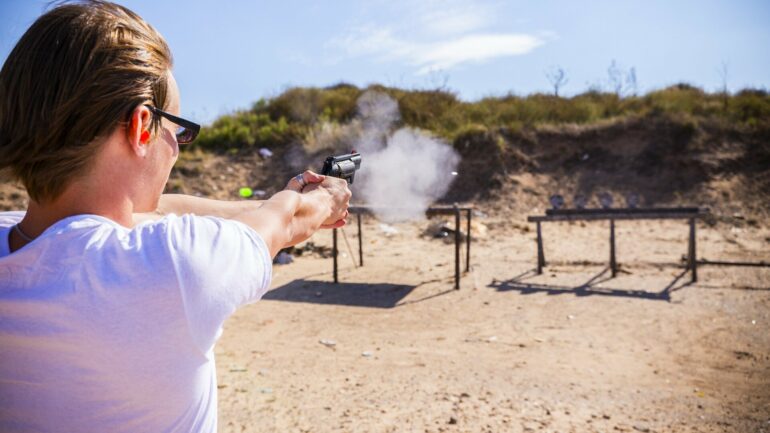Adolescents living in rural Washington state generally understand what constitutes acceptable firearm carrying behavior, according to a new study led by researchers at Washington State University.
Much of the existing data on adolescent firearm use and related behaviors comes from urban settings. This study, published in the journal JAMA Network Open, uses a mix of qualitative and quantitative research to paint a detailed picture of rural youths’ interactions with firearms and their perceptions of firearm-related social norms in their communities.
“This research demonstrates that rural adolescents are typically engaging with firearms in pro-social ways like hunting, recreation, and sport,” said Elizabeth Weybright, associate professor in WSU’s Department of Human Development and the study’s corresponding author. “Youth in the study generally understood what is and isn’t appropriate, and they knew how expectations for adults and adolescents differ. This aligns with the state’s legal requirements allowing minors to use a firearm under certain conditions.”
Social norms play a significant role in adolescent health behaviors, both positive and negative, and they are often a focus of efforts to change behavior. Understanding the context in which young people use firearms is critical to creating an approach that aligns with rural culture to prevent firearm-involved injuries and deaths in those settings, the authors said.
With firearm injury now the primary cause of death for children and adolescents in the United States, the quest for a solution carries a special sense of urgency.
“This research is an important first step toward firearms injury prevention practices in rural communities,” said Ashley Hall, WSU Extension 4-H assistant professor and study co-author. “To tailor prevention efforts, we need to understand the populations we are working with. Hearing from rural Washington youth is a way for us to incorporate their voices and unique perspectives.”
Using surveys, focus groups, and individual interviews, the researchers gathered information from nearly 100 male and female adolescents aged 12 to 19 years. All participants were living in rural Washington state and enrolled in a county or tribal WSU Extension 4-H youth development program at the time of the study.
“This project would not have happened without the partnership of Extension and 4-H,” said Weybright, an adolescent Extension specialist in WSU’s human development department. “Working with colleagues like Ashley allowed us to have open and honest conversations with youth.”
The focus group participants were very candid, the researchers said. Many adolescents readily shared their opinions and experiences even when they conflicted with those of their peers.
“The youth were not just willing; they were excited to share their perspectives,” Hall said. “Sometimes we forget how intelligent and resourceful youth are. They are quite literally our future, and I was excited to learn from them in this study.”
Participants responded to a variety of questions including whether they had previously carried a handgun, the age at which they first carried one, where they carried it, and their reasons for doing so. The study lent itself well to a mix of quantitative and qualitative data, which helped the researchers identify several recurring themes around firearm use.
“The benefit of the mixed methods approach is that you can blend the data together to draw broader conclusions and understand the topic in a more complete way,” Weybright said. “Quantitative data provides numbers, while qualitative data offers a rich description and context for those numbers.”
Many study participants said they understood that youths require adult supervision while using a firearm. Some also emphasized the importance of receiving training before handling a firearm. The researchers were especially encouraged by those findings.
“We’re starting from a great spot,” said Weybright. “This study highlights rural adolescents’ focus on not only training but also safety when it comes to firearms. It points to how we can build on this foundation to support firearm injury prevention in rural homes.”
Though data on firearm-related behaviors in rural communities is limited, WSU researchers are continuously filling in the gaps. This study is the culmination of a years-long, collaborative project with the University of Washington, Seattle Children’s Research Institute, and Arizona State University that centers on rural adolescents’ interactions with firearms. As part of this collaboration, Weybright helped investigate how early prevention systems can reduce gun violence among rural youth. As a next step in this work, Weybright and Hall are examining parents’ perspectives on their adolescents’ involvement in firearm safety practices in rural communities.
“The ultimate goal is the elimination of firearm injury and death for all populations,” Hall said. “In the short-term, I hope that we can understand firearms users and that our understanding leads to meaningful communication and change.”
More information:
Elizabeth H. Weybright et al, Firearm Experiences, Behaviors, and Norms Among Rural Adolescents, JAMA Network Open (2024). DOI: 10.1001/jamanetworkopen.2024.41203
Provided by
Washington State University
Citation:
Many rural Washington state youth engage in socially acceptable firearm-related behaviors (2024, October 24)



